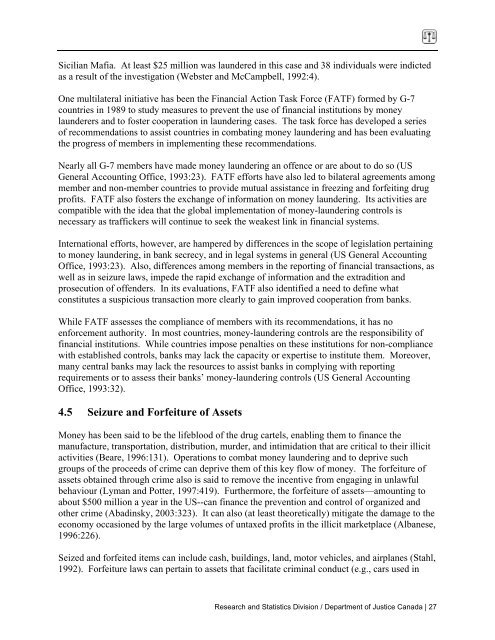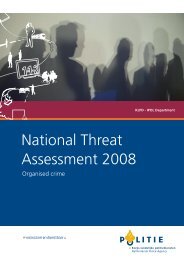Assessing the Effectiveness of Organized Crime Control Strategies ...
Assessing the Effectiveness of Organized Crime Control Strategies ...
Assessing the Effectiveness of Organized Crime Control Strategies ...
Create successful ePaper yourself
Turn your PDF publications into a flip-book with our unique Google optimized e-Paper software.
Sicilian Mafia. At least $25 million was laundered in this case and 38 individuals were indicted<br />
as a result <strong>of</strong> <strong>the</strong> investigation (Webster and McCampbell, 1992:4).<br />
One multilateral initiative has been <strong>the</strong> Financial Action Task Force (FATF) formed by G-7<br />
countries in 1989 to study measures to prevent <strong>the</strong> use <strong>of</strong> financial institutions by money<br />
launderers and to foster cooperation in laundering cases. The task force has developed a series<br />
<strong>of</strong> recommendations to assist countries in combating money laundering and has been evaluating<br />
<strong>the</strong> progress <strong>of</strong> members in implementing <strong>the</strong>se recommendations.<br />
Nearly all G-7 members have made money laundering an <strong>of</strong>fence or are about to do so (US<br />
General Accounting Office, 1993:23). FATF efforts have also led to bilateral agreements among<br />
member and non-member countries to provide mutual assistance in freezing and forfeiting drug<br />
pr<strong>of</strong>its. FATF also fosters <strong>the</strong> exchange <strong>of</strong> information on money laundering. Its activities are<br />
compatible with <strong>the</strong> idea that <strong>the</strong> global implementation <strong>of</strong> money-laundering controls is<br />
necessary as traffickers will continue to seek <strong>the</strong> weakest link in financial systems.<br />
International efforts, however, are hampered by differences in <strong>the</strong> scope <strong>of</strong> legislation pertaining<br />
to money laundering, in bank secrecy, and in legal systems in general (US General Accounting<br />
Office, 1993:23). Also, differences among members in <strong>the</strong> reporting <strong>of</strong> financial transactions, as<br />
well as in seizure laws, impede <strong>the</strong> rapid exchange <strong>of</strong> information and <strong>the</strong> extradition and<br />
prosecution <strong>of</strong> <strong>of</strong>fenders. In its evaluations, FATF also identified a need to define what<br />
constitutes a suspicious transaction more clearly to gain improved cooperation from banks.<br />
While FATF assesses <strong>the</strong> compliance <strong>of</strong> members with its recommendations, it has no<br />
enforcement authority. In most countries, money-laundering controls are <strong>the</strong> responsibility <strong>of</strong><br />
financial institutions. While countries impose penalties on <strong>the</strong>se institutions for non-compliance<br />
with established controls, banks may lack <strong>the</strong> capacity or expertise to institute <strong>the</strong>m. Moreover,<br />
many central banks may lack <strong>the</strong> resources to assist banks in complying with reporting<br />
requirements or to assess <strong>the</strong>ir banks’ money-laundering controls (US General Accounting<br />
Office, 1993:32).<br />
4.5 Seizure and Forfeiture <strong>of</strong> Assets<br />
Money has been said to be <strong>the</strong> lifeblood <strong>of</strong> <strong>the</strong> drug cartels, enabling <strong>the</strong>m to finance <strong>the</strong><br />
manufacture, transportation, distribution, murder, and intimidation that are critical to <strong>the</strong>ir illicit<br />
activities (Beare, 1996:131). Operations to combat money laundering and to deprive such<br />
groups <strong>of</strong> <strong>the</strong> proceeds <strong>of</strong> crime can deprive <strong>the</strong>m <strong>of</strong> this key flow <strong>of</strong> money. The forfeiture <strong>of</strong><br />
assets obtained through crime also is said to remove <strong>the</strong> incentive from engaging in unlawful<br />
behaviour (Lyman and Potter, 1997:419). Fur<strong>the</strong>rmore, <strong>the</strong> forfeiture <strong>of</strong> assets—amounting to<br />
about $500 million a year in <strong>the</strong> US--can finance <strong>the</strong> prevention and control <strong>of</strong> organized and<br />
o<strong>the</strong>r crime (Abadinsky, 2003:323). It can also (at least <strong>the</strong>oretically) mitigate <strong>the</strong> damage to <strong>the</strong><br />
economy occasioned by <strong>the</strong> large volumes <strong>of</strong> untaxed pr<strong>of</strong>its in <strong>the</strong> illicit marketplace (Albanese,<br />
1996:226).<br />
Seized and forfeited items can include cash, buildings, land, motor vehicles, and airplanes (Stahl,<br />
1992). Forfeiture laws can pertain to assets that facilitate criminal conduct (e.g., cars used in<br />
Research and Statistics Division / Department <strong>of</strong> Justice Canada | 27








